Improving customer service through AI with Freddy, the Chatbot
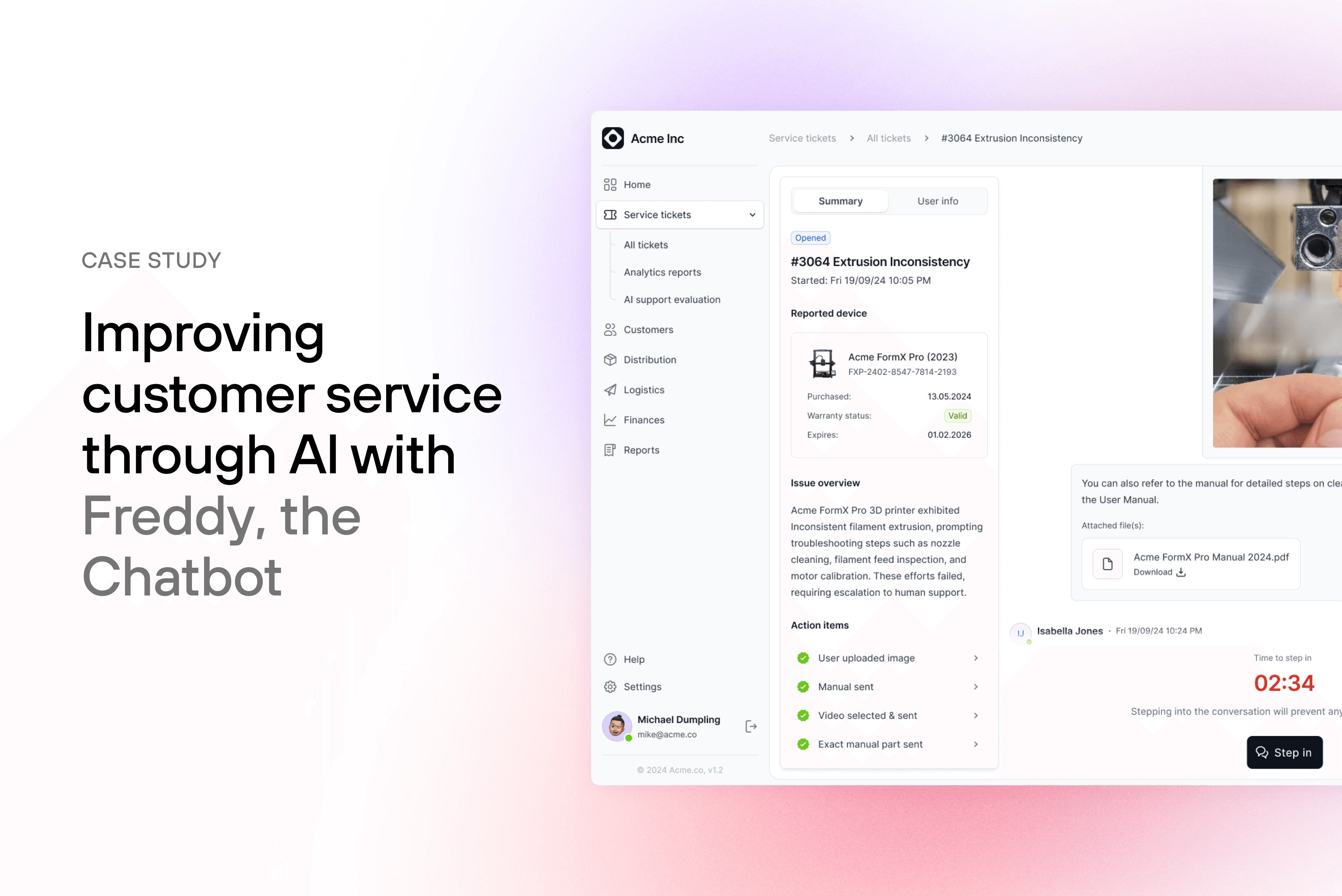
Overview
Autentika originally developed this Proof of Concept for a major hardware manufacturer, but due to confidentiality agreements, we are presenting it in the context of a 3D printer case for an organization we called Acme. The project is highly versatile and can be applied to similar scenarios across various industries, making it suitable for any complex hardware service environment.
Acme has implemented an AI-powered assistant, Freddy, into its customer support department. Freddy acts as a chatbot designed to assist customers in solving technical issues. Unlike traditional bots, Freddy utilizes AI to respond more dynamically to customer commands and provides multimedia solutions, including video tutorials and documentation excerpts. Additionally, Freddy can analyze photos submitted by users to detect hardware malfunctions. In cases where Freddy cannot resolve an issue, the system flags the ticket for human intervention, ensuring that an employee takes over within 15 minutes.
Our focus was to design and evaluate Freddy’s performance through two specific scenarios, both involving the role of the support agent, Michael. We will describe those scenarios in detail further in this case study.
The Challenge
The primary challenge of this case study was ensuring that the AI assistant, Freddy, could seamlessly support customer service operations without requiring excessive human oversight. While AI’s role was to reduce the workload on human agents, key areas needed improvement, particularly in handling more complex support tickets and ensuring that human intervention, when required, was timely and effective. Additionally, the AI’s ability to analyze multimedia data and interpret customer inputs in a nuanced manner posed another hurdle that needed to be overcome.
This solution is especially well-suited for manufacturers of complex devices, where manuals and instructions can span thousands of pages and include multimedia elements. Furthermore, skilled technicians with deep knowledge of servicing these products are often scattered globally, leading to delays of several days while waiting for their responses.
Customer service operations were performed by specialized agents who relied on their expertise and manuals to service the 3D printers. This was time-consuming and required constant human intervention.
90% of the work is automated and handled by AI assistant Freddy, with humans supervising the process. This shift has streamlined operations, reduced manual labor, and improved efficiency.
The objective was to ensure:
- Reduced time needed to complete a service ticket
- Increased efficiency in handling tickets, allowing the human team to focus on more critical tasks.
- Successful autonomous problem-solving for common printer issues through AI.
Projected results
Based on the project assumptions, the hypothetical expected results could be:
-
Ticket resolution efficiency: Freddy successfully handled a majority of common support inquiries autonomously, reducing the number of tickets escalated to human agents.
-
Faster response times: The introduction of Freddy allowed Acme to reduce average customer wait times, ensuring that those who required human assistance received help within the 15-minute guarantee.
-
Enhanced customer satisfaction: Customers responded positively to Freddy’s multimedia-driven approach to troubleshooting, with a visible increase in satisfaction scores for tickets resolved by AI.
-
Human agent optimization: Freddy’s ability to handle simpler tasks allowed human agents to focus on more complex issues, improving overall productivity and job satisfaction among support staff.
Scenario 1: AI-Assisted Support (Human Intervention)
In the first scenario, we simulated a situation where a customer encountered an issue that Freddy could not resolve. Freddy initiates a chat to troubleshoot the problem using its knowledge base. It analyzes the user's 3D printer model, diagnoses the issue based on the photo sent by the user, and provides multimedia resources, such as video tutorials or relevant documentation.
However, when Freddy cannot offer a solution, the issue is flagged for human support. The customer support agent Michael sees the ticket marked as "Human Intervention Needed" in the dashboard, highlighting the tickets AI couldn’t resolve.
Here are the action steps in detail:
1) Viewing the ticket list
A support agent can view tickets and see which other team members are currently working on them. Multiple agents can review a ticket simultaneously, but once an agent takes ownership, the ticket is locked for others.
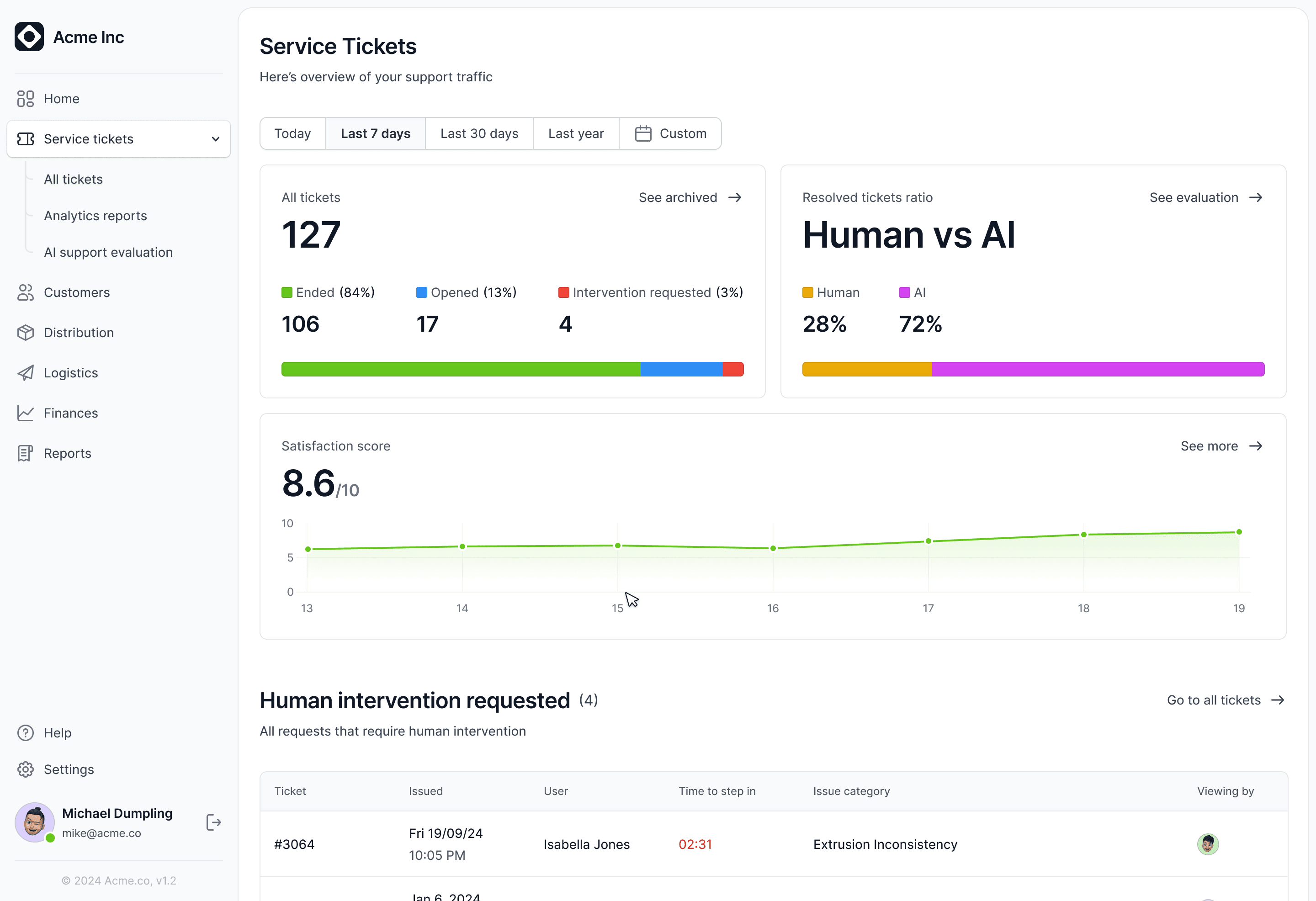
2) Selecting a ticket
Agent Michael selects a ticket that requires human intervention.
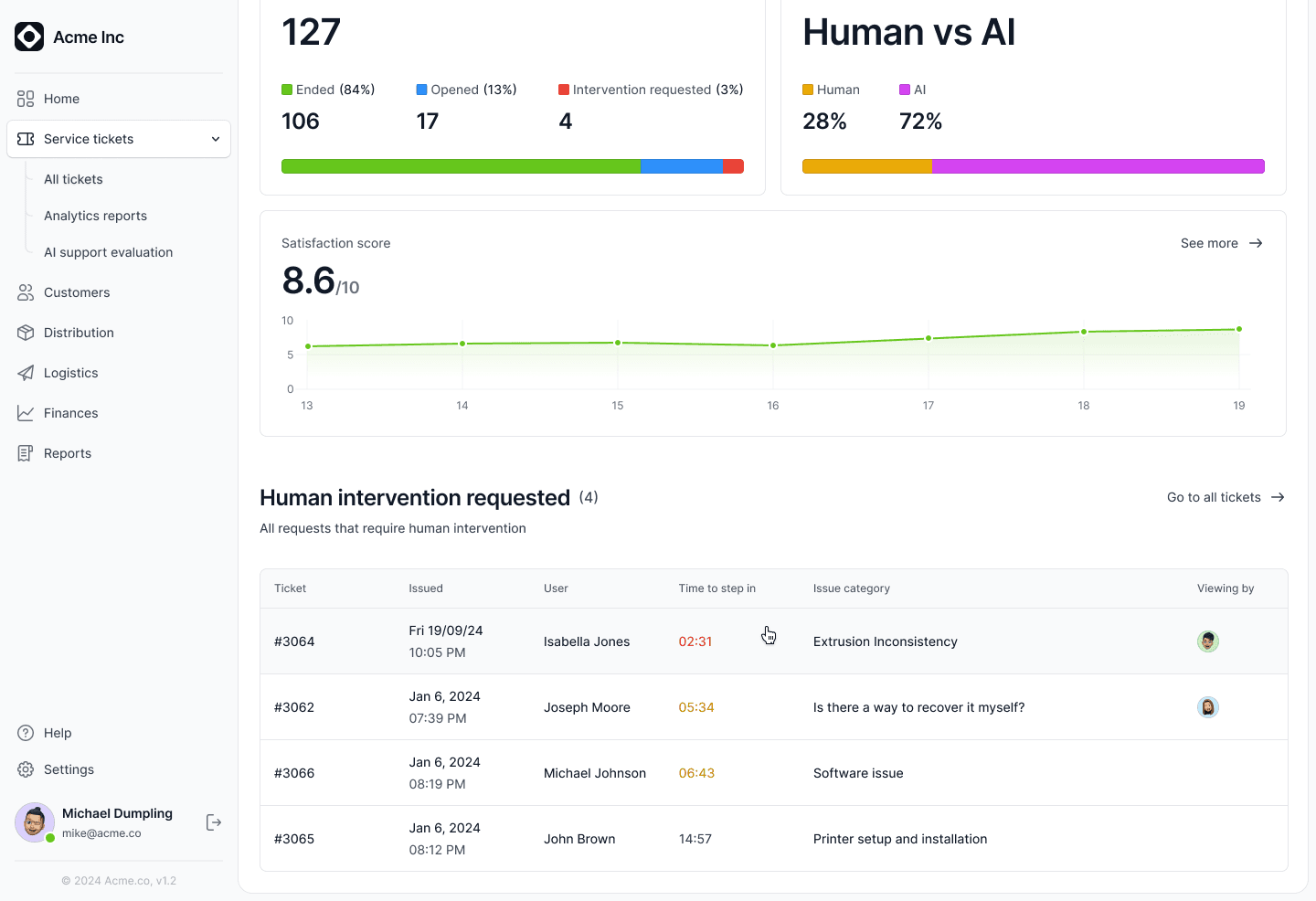
The agent accesses the ticket and the issue summary. What’s important is that AI prepares a summary of the entire issue, names it, and provides key elements of the problem.
The interface includes a timer at the bottom of the chat window, indicating the time left for an agent to take over. A similar timer appears at the top of the screen.
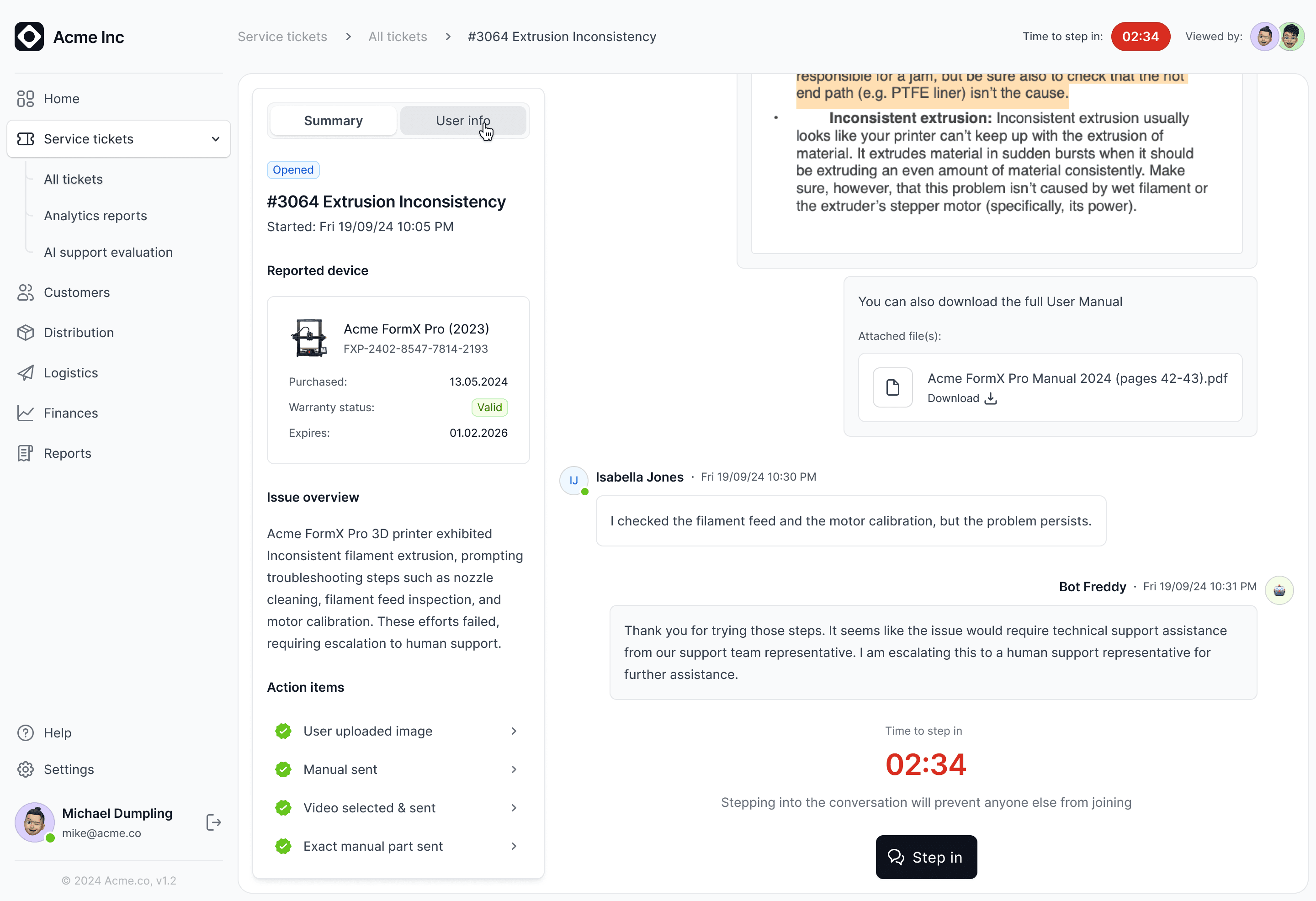
3) Reviewing user info
Michael can use the remaining time on the timer to review the user’s information in the left panel. Since the user is registered, the support agent can access relevant details such as the user’s location, registered hardware (e.g., 3D printers), warranty type (e.g., subscription plan), and links to the user’s past tickets for reference.
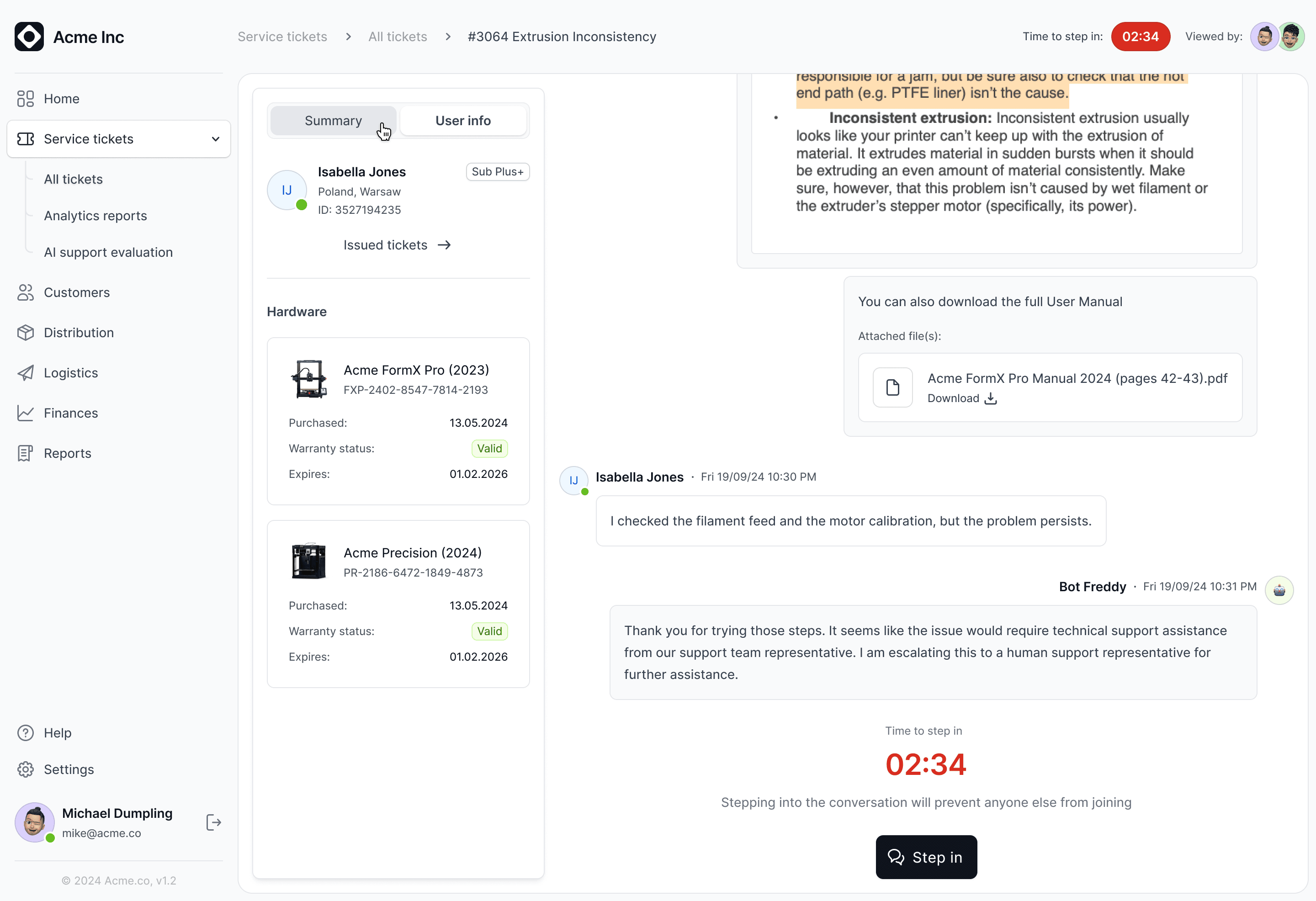
Additionally, “Action Items” section helps navigate through the discussion history. Clicking an action item scrolls to the corresponding part of the chat.
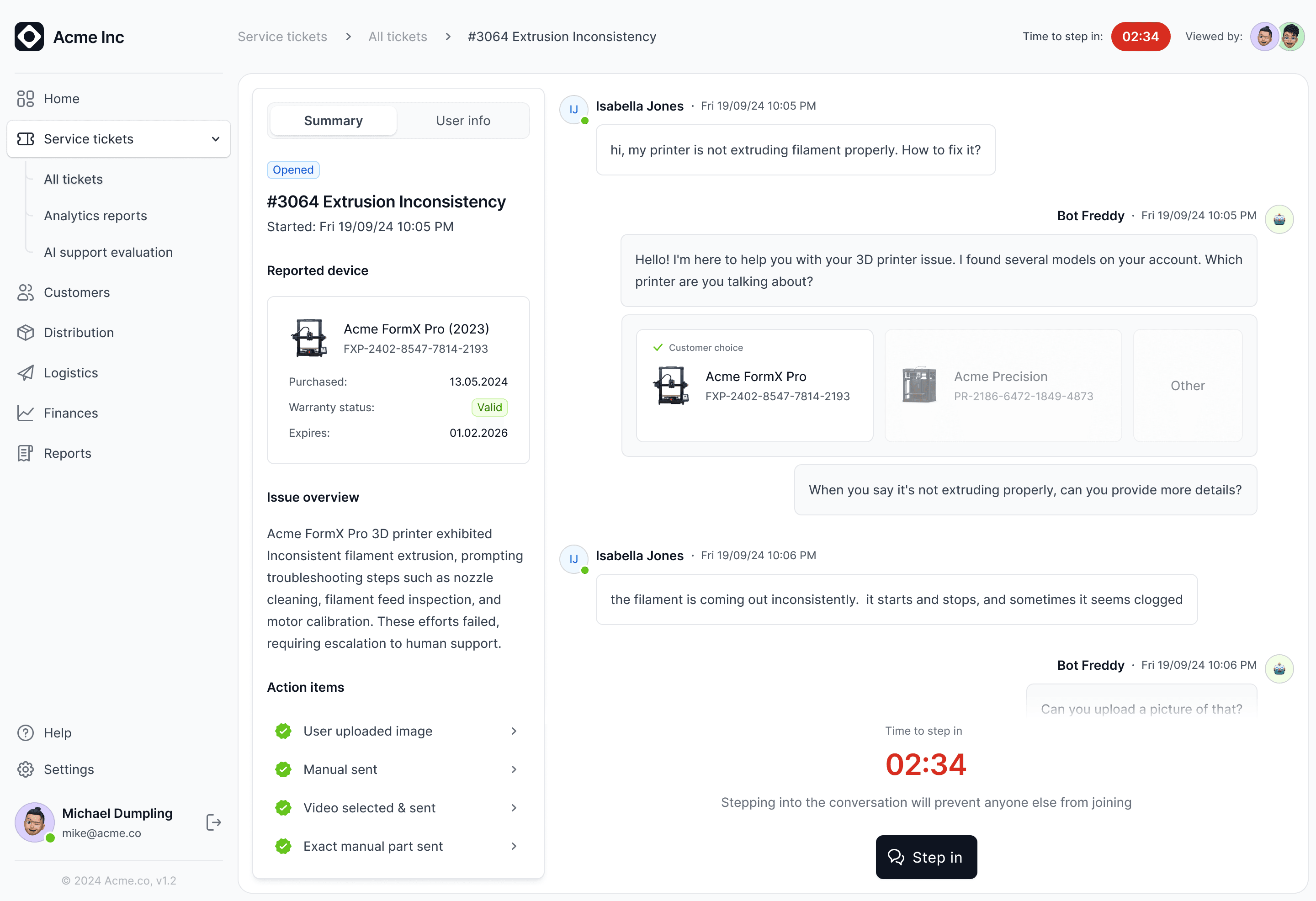
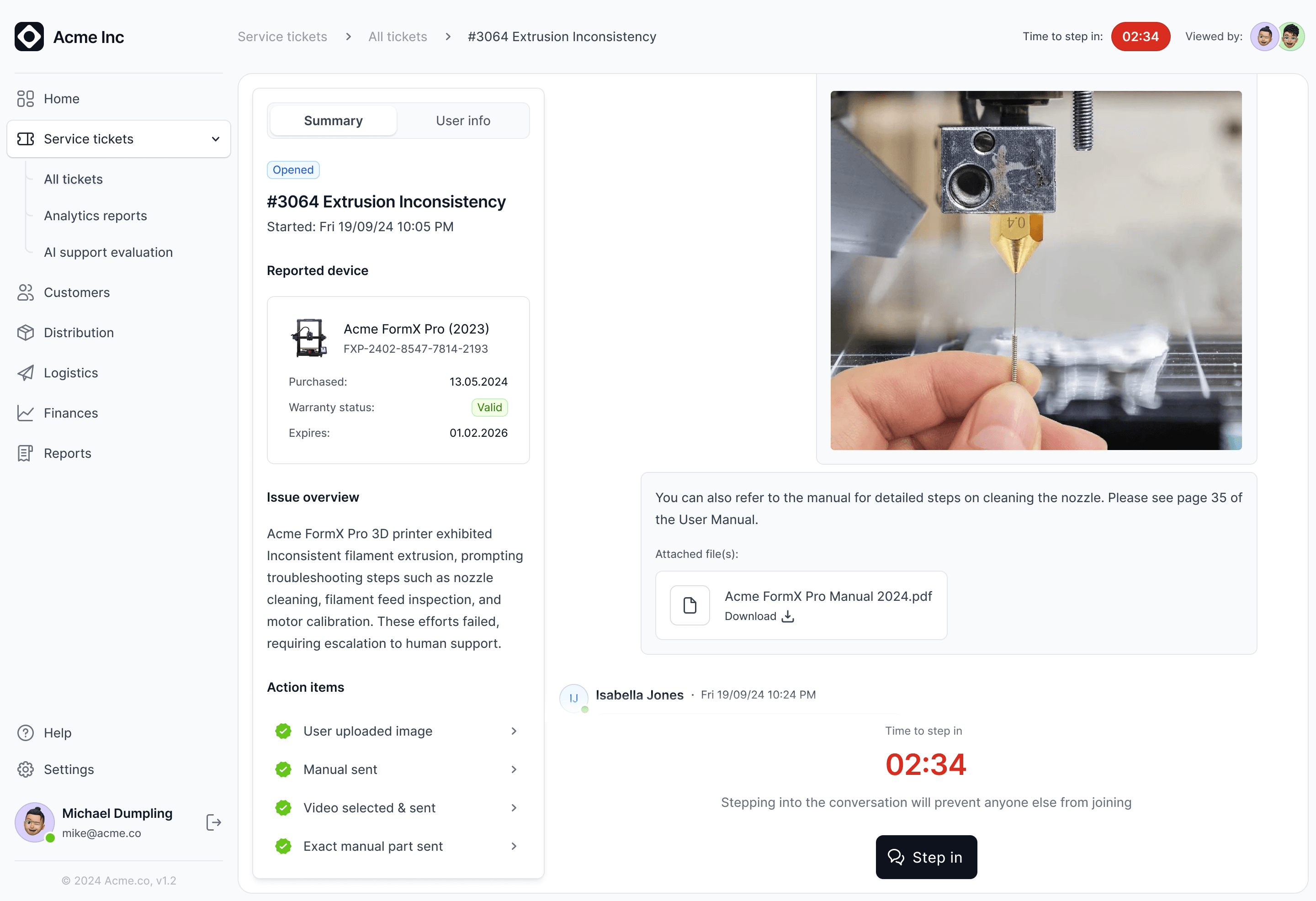
4) Taking over the ticket
Michael decides to take over the ticket.
This action disables the timer, and the user is notified that a human agent is now handling her issue.
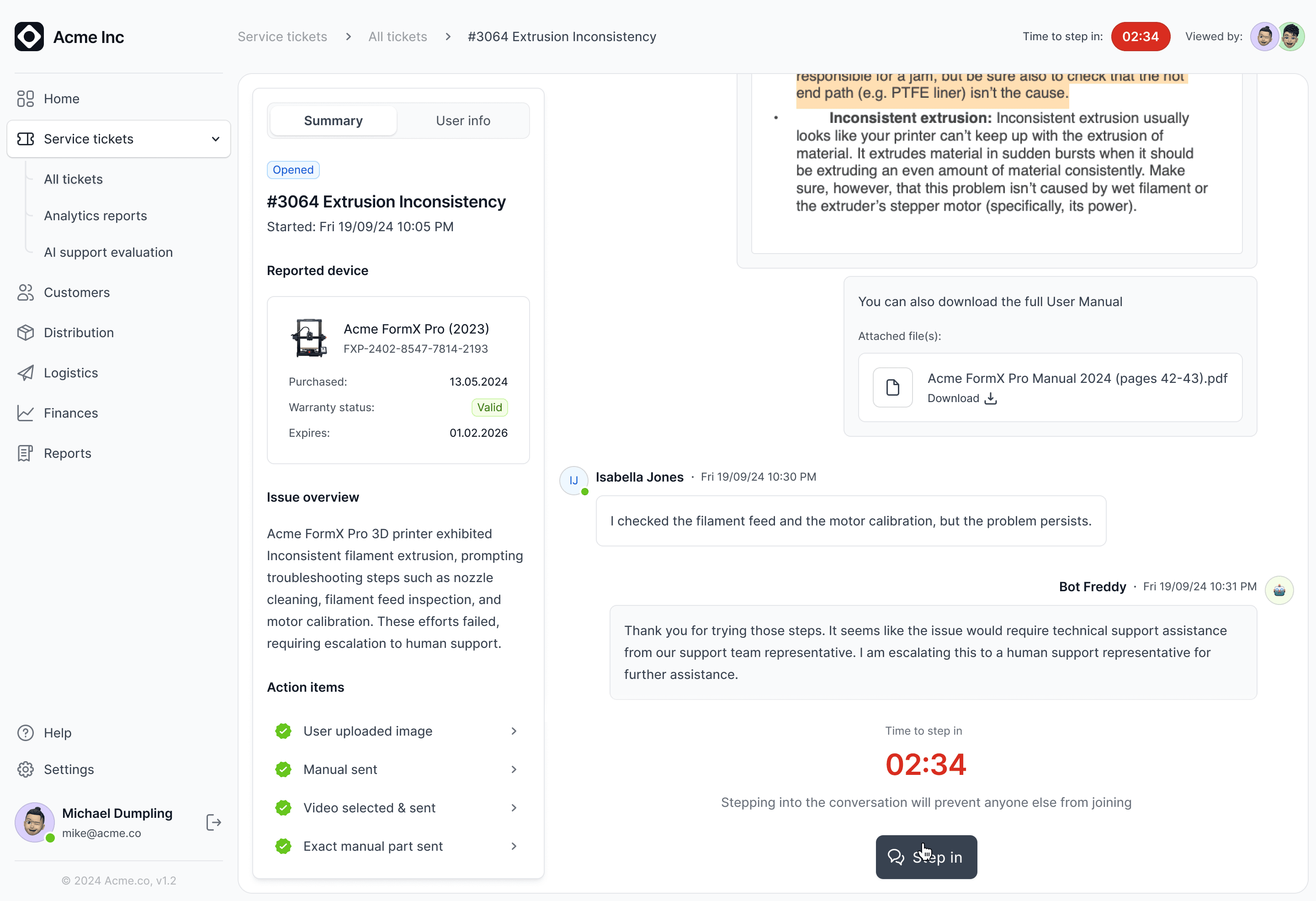
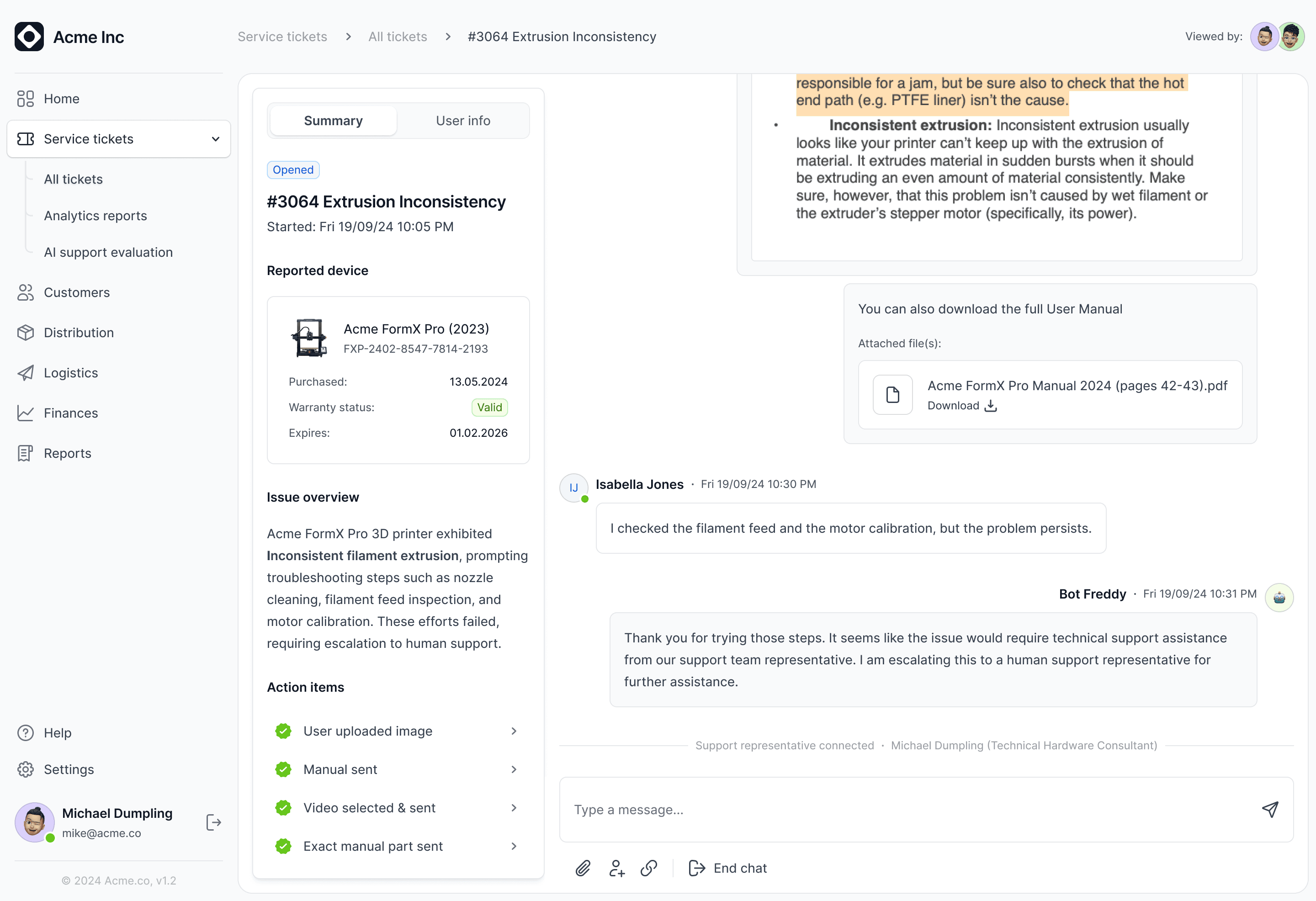
Let’s also have a look at the possible chat between Freddy and the user, preceding the human intervention:
(the case study continues below the screenshot)

Here’s the flow of the chat:
-
AI first attempts to gather information about the issue. It pulls details from the customer’s account and displays the registered devices.
-
The user submits a photo of the problem. AI analyzes the image and diagnoses the issue (in this case, a clogged nozzle on the 3D printer).
-
AI provides contextual help, including a photo illustrating the next steps, a link to the relevant section of the manual (downloadable), a video link with a specific timestamp that demonstrates the issue.
-
AI pulls a relevant section from a document and highlights the exact passage the user needs.
-
At this point, AI acknowledges that it cannot solve the issue. The user is waiting for human assistance, and Michael is ready to step in and continue the work from here.
Key takeaways
Scenario 2: Evaluation of AI performance
In the second scenario, Michael shifts from active support to reviewing tickets that Freddy closed autonomously. After a customer uses Freddy and resolves an issue, they are prompted to rate their satisfaction. Michael evaluates these closed tickets to ensure the AI is providing high-quality service.
1) Viewing closed tickets in "AI Support Evaluation"
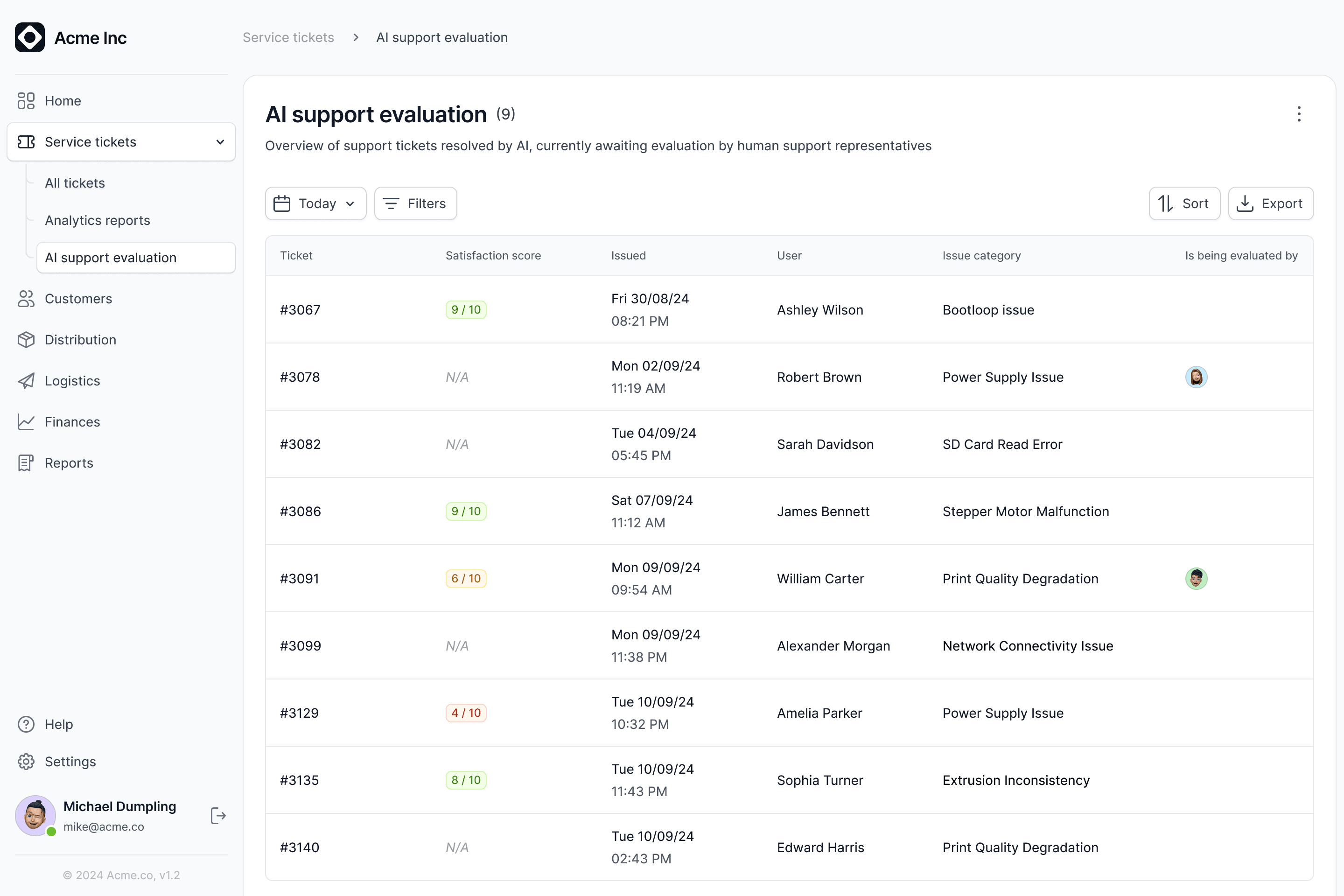
2) Selecting a ticket
Michael selects his first ticket to evaluate.
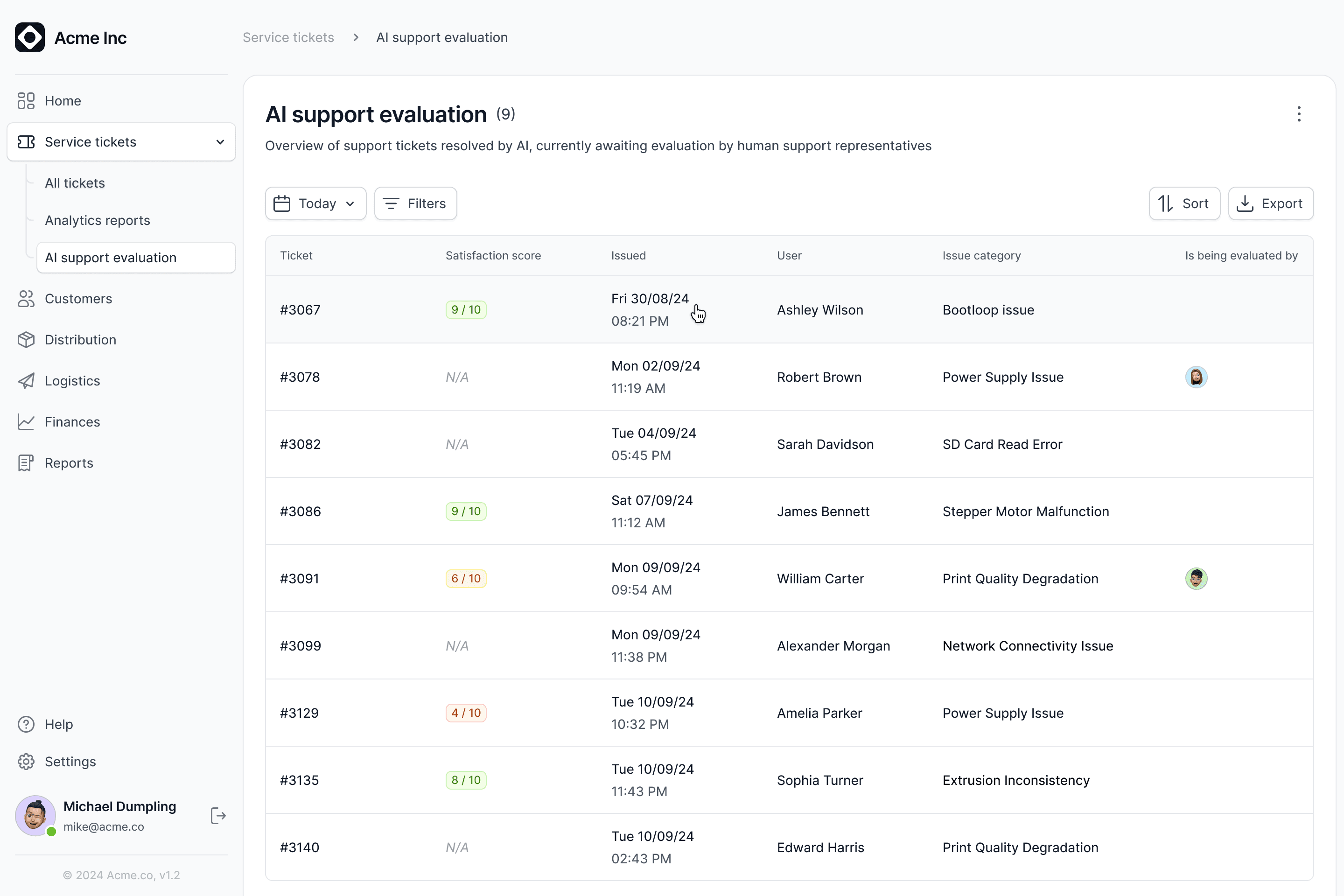
The ticket view consists of two columns:
- Ticket Summary and User Info
- Chat History between the AI and the user.
The Summary (prepared by AI) outlines the specific issue (including the model and a discussion overview). The summary also highlights important milestones, or Action Items, achieved during the support process.
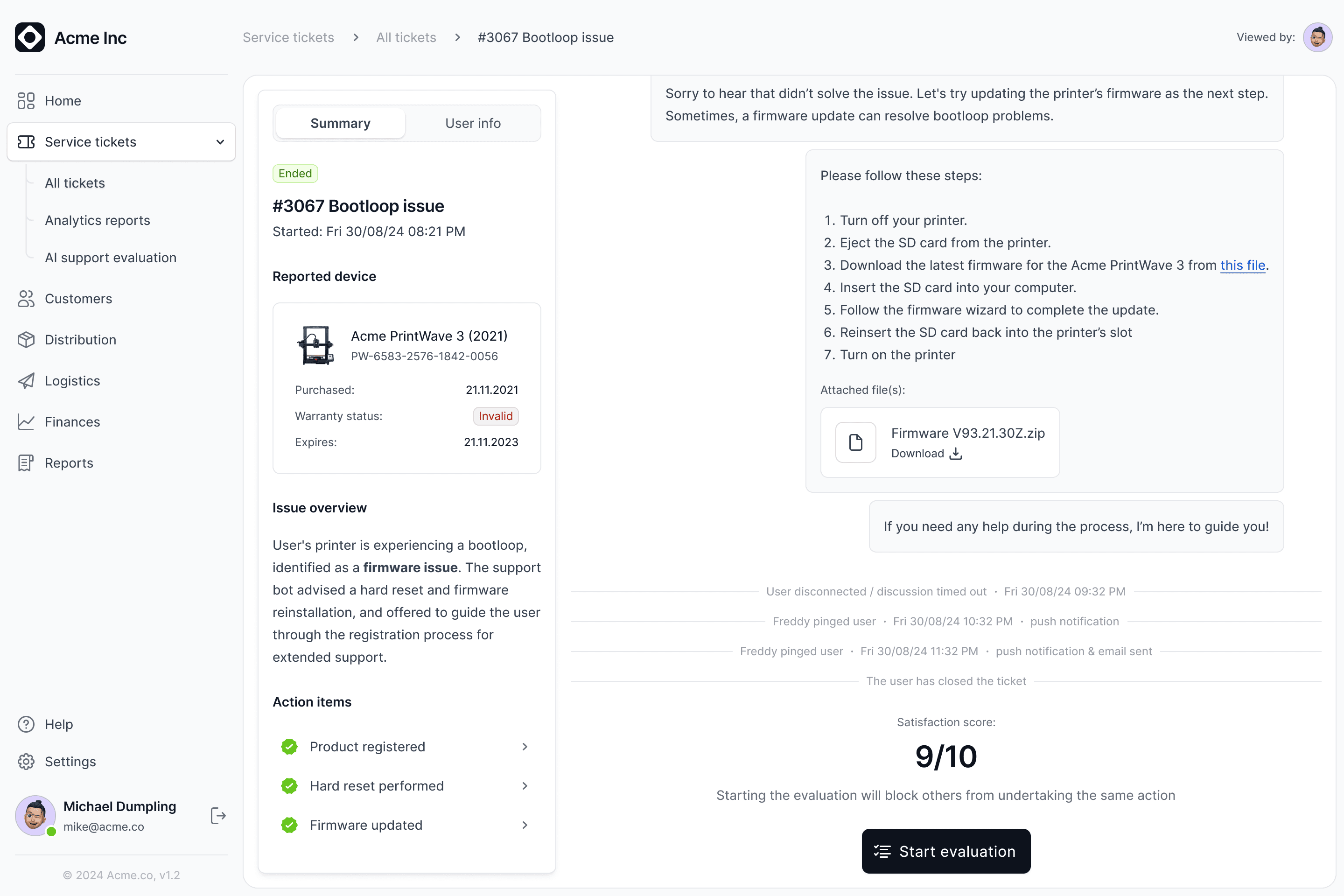
3) Starting the evaluation
Michael begins evaluating the ticket. He has two options:
1) Accept the ticket: Mark the conversation as successful, which AI can use as feedback for future learning.
2) Escalate the ticket to another department:
- Accounting: If the customer needs further sales-related follow-up.
- AI Training Department: If the AI made a significant mistake and requires retraining (Michael only flags these cases, while another team handles retraining).
In our scenario, Michał decides to accept the ticket.
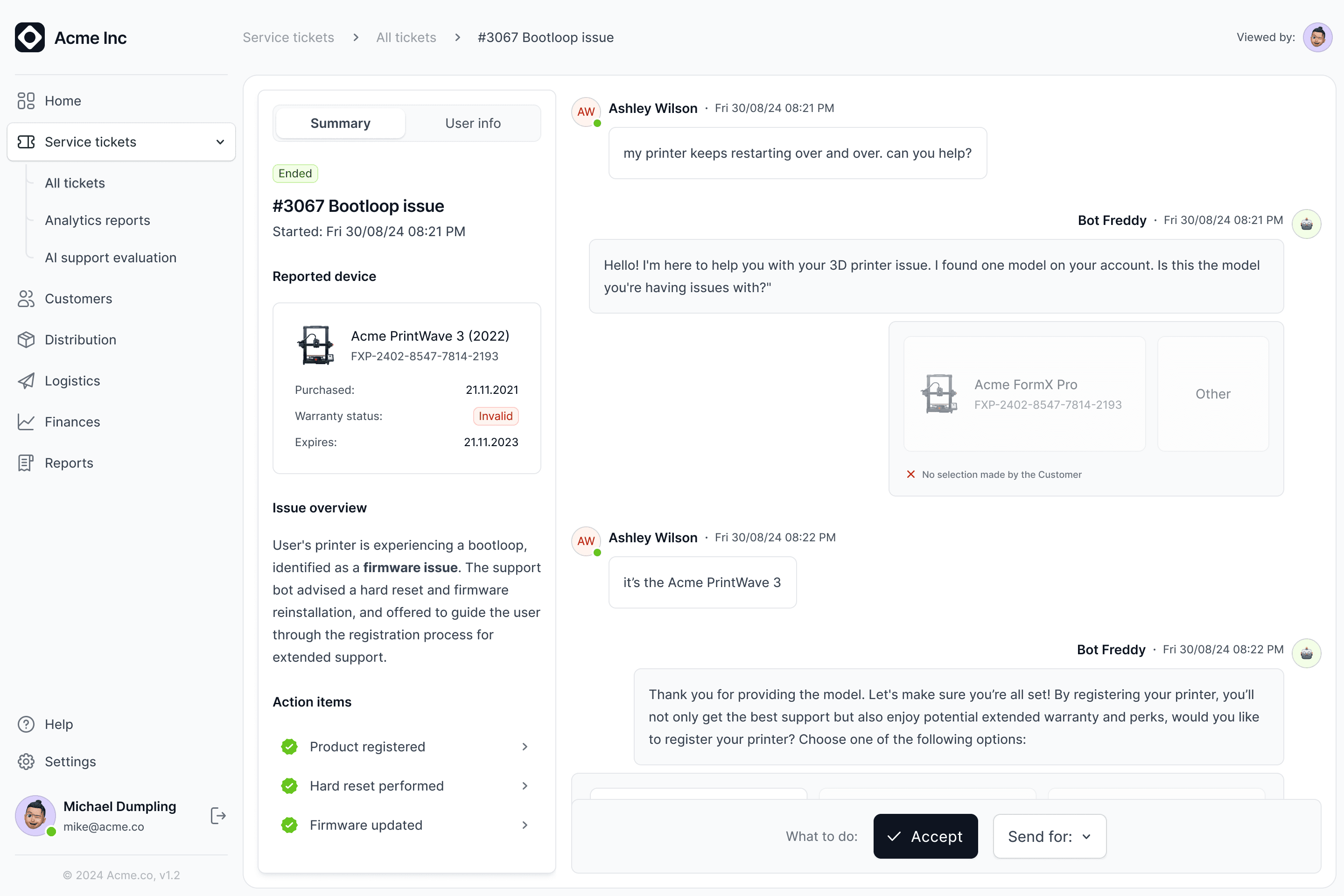
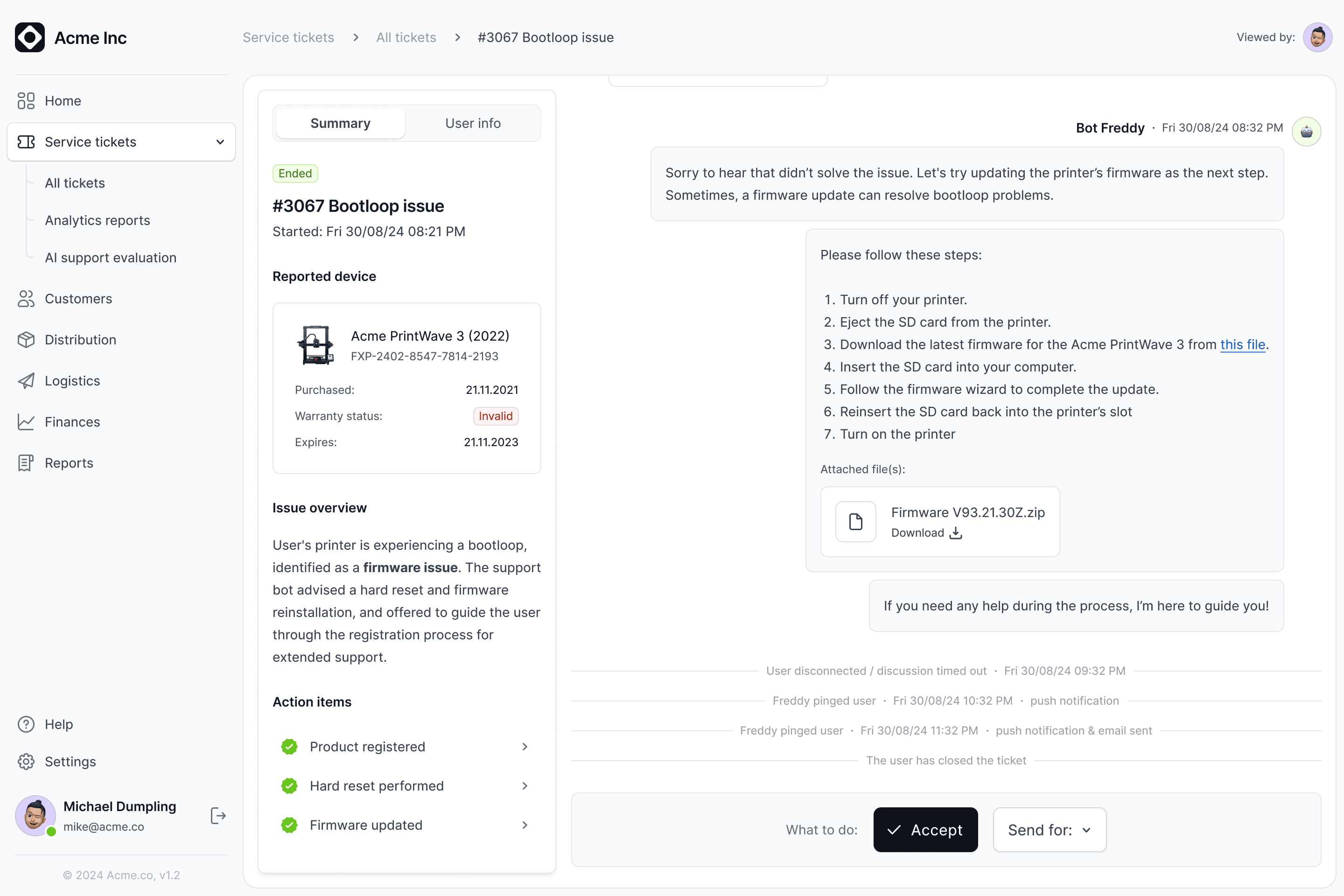
Let’s also have a look at the possible chat between Freddy and the user, preceding the ticket evaluation.
(the case study continues below the screenshot)

Here’s the flow of the chat:
-
AI initially retrieves the customer’s registered equipment information (since the user is logged in).
-
The AI tries to confirm the device's model. However, the user skips the AI’s options and types the model directly into the chat.
-
The user mentions a model that isn’t registered on their account.
-
AI offers to help register the equipment, suggesting three options for registration.
-
The user opts to upload a photo of the equipment label for quick registration.
-
Based on the uploaded photo, the AI swiftly registers the equipment.
-
AI then returns to address the original issue.
-
The user receives the necessary file from the AI, uploads it to the 3D printer, and fixes the issue.
-
Satisfied with the solution, the user leaves the chat without closing the ticket.
-
AI notices the user has dropped the session and pings them with a gentle reminder to close the ticket.
-
When the first reminder gets no response, AI follows up with a push notification and a Critical Hit email.
-
The user comes back, closes the ticket, and leaves a positive satisfaction score.
-
Support agent Michael confirms that AI successfully handled the case, and the user was satisfied.
Key takeaways
- User feedback integration: Freddy prompts users to close tickets and leave feedback. If no feedback is given, Michael can investigate to ensure the ticket was resolved appropriately, addressing any potential gaps in Freddy’s service.
Ticket review process: We designed a system where Michael could review both the process and outcomes of AI-handled cases. If an issue was resolved but the feedback is negative, Michał can re-open the ticket to see where the AI fell short.
AI learning & refinement: Based on Michael’s review, we implemented a feedback loop where AI is updated to improve on areas where it may have faltered. This ensures continuous learning and reduces future reliance on human intervention.
Advanced AI Capabilities
One of the key differentiators for Freddy was its ability to handle complex media. We worked on enabling Freddy to:
- Analyze images submitted by customers to diagnose hardware issues.
- Read and interpret documents to extract relevant solutions for customers.
- Direct customers to precise moments in video tutorials to address specific problems. This greatly enhanced the AI’s ability to address issues independently, reducing the number of tickets escalated to human agents.
